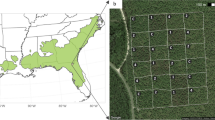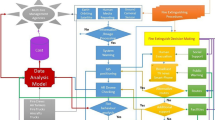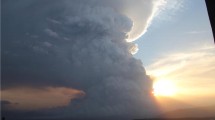Abstract
The Canadian Forest Fire Danger Rating System (CFFDRS) is used daily across Canada for evaluating forest fire danger. Fuel-type information is one of the inputs required by the models used in the CFFDRS. In this project, three fuel-type maps with a 25 m resolution were produced for a pilot study area located in Alberta using land cover only; land cover and biomass; and, land cover, biomass and leaf area index data derived from satellite imagery. The relationships between inputs and fuel types were determined mainly by the opinions of forest fire scientists and incorporated into a computer program using fuzzy set methodology. Not all the CFFDRS fuel types could be distinguished using these inputs; three of the coniferous types had to be grouped into one common fuel type. Overall accuracy was between 74 and 83% based on ground-truth comparisons. The most accurate map resulted from land cover and biomass data. Detailed accuracy assessment indicated that the overall accuracy increased up to 86% if ambiguous fuel type identification was considered. No combination of inputs was able to define a fuel type with absolute certainty, which is a reflection of differing expert opinions and the small number of inputs used to produce the maps.
Similar content being viewed by others
References
Agriculture and Agri-Food Canada: 2000, ‘Canadian soil information system’, Available at http://sis.agr.gc.ca/cansis//intro.html. (updated 9 November 2002; cited 10 January 2004).
Agricultural, Food and Rural Development: 2005, ‘Agricultural region of alberta soil inventory database’ (online). Available from http://www1.agric.gov.ab.ca/$department/deptdocs.nsf/all/sag3249?opendocument. (Revised March 1 2005, cited March 5 2005).
Anderson, K. R.: 2002, ‘A model to predict lightning-caused fire occurrences’, Int. J. Wildland Fire 11, 163–172.
Anderson, K. R.: 2001, ‘A model to predict lighting-caused fire occurrences’, in: Proceedings, American Meteorological Society, 4th Symposium on Fire and Forest Meteorology, 12–15 November 2001. Reno, Nevada. pp. 206–212.
Bare, B. B. and Mendoza, G. A.: 1988, ‘Soft optimization approach to forest land management planning’, Can. J. For. Res. 18, 545–552.
Beckingham, J. D., Desilets, M., Nielsen, D. and Johns, F.: 1999, ‘Multi-layered and statistically based ecosystem mapping: The de facto standard for land resource planning in the 21st century’, Earth Obs. Mag. 8, 10–13.
British Columbia Ministry of Forests: 2001, Vegetation Resources Inventory: The B.C. Land Cover Classification Scheme, Ministry of Forests, Resources Inventory Branch, for the Terrestrial Ecosystems Task Force Resources Inventory Committee, Victoria, British Columbia. 37 pp.
Canadian Interagency Forest Fire Centre: 2003, ‘2003 glossary of forest fire management terms’ (online). Available from http://www.ciffc.ca under downloads (cited 22 February 2005).
Chen, J. M., Pavlic, G., Brown, L., Cihlar, J., Lebland, S. G., White, H. P., Hall, R. J., Peddle, D. R., King, D. J., Trofymow, J. A., Swift, E., Vander Sanden, J. and Pellikka, P. K. E.: 2002, ‘Derivation and validation of Canada-wide coarse-resolution leaf area index using high–resolution satellite imagery and ground measurements’, Remote Sensing Environ. 80, 165–184.
Congalton, R.: 1991, ‘A review of assessing the accuracy of classifications of remotely sensed data’, Remote Sensing Environ. 37, 35–46.
Congalton, R. G. and Green, K.: 1993, ‘A practical look at the sources of confusion in error matrix generation’, Photogrammetric Eng. Remote Sensing 59, 641–644.
Dumanski, J., Macyk, T. M., Veauvy, C. F. and Lindsay, J. D.: 1972, ‘Soil survey and land evaluation of the Hinton-Edson area, Allberta’, Alberta Institute of Pedology, Research Council of Alberta, Alberta Soil Survey Report No. S-72-31, 119 pp.
Environment Canada: 2003a, ‘Alberta–Foothills Model Forest’ (online). Available at http://www.cfl.nrcan.gc.ca/ECOLEAP/pilot_regions/alberta_e.html (cited 16 August 2004).
Environment Canada: 2003b, ‘Narrative descriptions of terrestrial ecozones and ecoregions of Canada’ (online). Available at http://www.ec.gc.ca/soerree/English/Framework/NarDesc/canada_e.cfm (updated 18 October 2003; cited 10 January 2004).
Foody, G. M.: 2002, ‘Status of land cover accuracy assessment’, Remote Sensing Environ. 80, 185–201.
Forestry Canada Fire Danger Group: 1992, ‘Development and structure of the Canadian forest fire behavior prediction system’, Forestry Canada, Science for Sustainable Development, Ottawa, Ontario. Information Report ST-X-3, 63 pp.
Geographic Dynamics Corp: 1999, ‘Ecological classification of the Drayton Valley Forest Management Agreement Area using Sitelogix’, Prepared for Weyerhaeuser Canada Ltd. by Geographic Dynamics Corp., Edmonton, AB, 46 pp.
Gopal, S. and Woodcock, C.: 1994, ‘Theory and methods for accuracy assessment of thematic maps using fuzzy sets’, Photogrammetric Eng. Remote Sensing 60, 181–188.
Guindon, L., Fournier, R. A., Beaudouin, A., Luther, J. E., Hall, R. J., Piercey, D. E., Arsenault, E., Lambert, M.C. and Case, B.: 2002, ‘Mapping forest biomass on several pilot regions in Canada with Landsat Tm and Forest inventory Data’, Proceedings, International Geoscience and Remote Sensing Symposium/24th Canadian Symposium on Remote Sensing, 24–28 June 2002. Toronto, Ontario. pp. 886–888.
Hall, R. J., Case, B. S., Arsenault, E., Price, D. T., Luther, J. E., Piercey, D. E., Guindon, L. and Fournier, R. A.: 2002, ‘Modeling and mapping forest biomass using forest inventory and Landsat TM data: Results from the Foothills Model Forest, Alberta’, Proceedings, International Geoscience and Remote Sensing Symposium/24th Canadian Symposium on Remote Sensing, 24–28 June 2002. Toronto, Ontario. pp. 1320–1323.
Hawkes, B. C., Beck, J. and Sahle, W.: 1996, ‘A wildfire threat rating system for the McGregor Model Forest’, Proceedings of the 13th Fire and Meteorology Conference, 28–31 Oct. 1996. International Association of Wildland Fire, Fairfield, Washington. pp. 149–160.
Keane, R. E., Burgan, R. and van Wagtendonk, J.: 2001, ‘Mapping wildland fuels for fire management across multiple scales: integrating remote sensing, GIS and biophysical modeling’, Int. J. Wildland Fire 10, 301–319.
Laba, M., Gregory, S. K., Braden, J., Ogurcak, D., Hill, E., Fegraus, E., Fiore, J. and DeGloria, S. D.: 2002, ‘Conventional and fuzzy accuracy assessment of the New York gap analysis project land cover map’, Remote Sensing Environ. 81, 443–455.
Lee, B. S.: 1995, ‘The Canadian wildland fire information system’, Ninth Annual Symposium on Geographic Information Systems, Vancouver, British Columbia, pp. 639–655.
Lee, B. S., Alexander, M. E., Hawkes, B. C., Lynham, T. J., Stocks, B. J. and Englefield, P.: 2002, ‘Information systems in support of wildland fire management decision in Canada’, Comput. Electron. Agric. 37, 185–198.
Luther, J. E., Fournier, R. A., Hall, R. J., Ung, C.-H., Guidon, L., Piercey, D. E., Lambert, M.-C. and Beaudoin, A.: 2002, ‘A strategy for mapping Canada's forest biomass with Landsat TM imagery’, Proceedings, International Geoscience and Remote Sensing Symposium/24th Canadian Symposium on Remote Sensing, 24–28 June 2002, Toronto, Ontario. pp. 1312–1315.
MamDani, E.: 1975, ‘An experiment in linguistic synthesis with a fuzzy logic controller’, Int. J. Man-Machine Stud. 7, 1–13.
Morgan, P., Hardy, C. C., Swetman, T. W., Rollins, M. G. and Long, D. G.: 2001, ‘Mapping fire regimes across time and space: Understanding coarse and fine-scale fire patterns’, Int. J. Wildland Fire 10, 329–342.
Muller, S. V., Walker, D. A., Nelson, F. E., Auerbach, N. A., Bockheim, J. G., Guyer, S. and Sherba, D.: 1998, ‘Accuracy assessment of land-cover map of the Kuparuk river basin, Alaska: Considerations for remote regions’, Photogrammetric Eng. Remote Sensing 64, 619–628.
Nadeau, L. B., Li, C., Corns, I. G. W.: 2002, Computerized Plant Community Classification: An Application of Fuzzy Logic, Natural Resources Canada, Canadian Forestry Service, Northern Forestry Centre, Edmonton, Alberta, Information Report NOR-X-384. 22 pp.
Nadeau, L. B., Li, C., Hans, H.: 2004, ‘Ecosystem mapping in the lower foothills subregion of Alberta: Application of fuzzy logic’, For. Chron. 80, 359–365.
Natural Resources Canada: 2002, ‘Canada's Forest Inventory’ (online). Available from http://www.pfc.forestry.ca/monitoring/inventory/canfi/faq_e.html. (updated 19 December 2002; cited 10 January 2004).
Price, D. T., Hall, R., Raulier, F., Linder, M., Case, B. and Bernier, P.: 2002, Simulating Climatic Impact on and Adaptive Management Options for, Boreal Forest Ecosystems in Western Canada, Final report to Prairie Adaptation Research Cooperative, Foothills Model Forest, and the Sustainable Forest Management Network, Canadian Forest Service, Northern Forestry Centre, Edmonton, Alberta, 104 pp.
Roberts, D. M.: 1989, ‘Fuzzy systems vegetation theory’, Vegetatio 83, 71–80.
Rowe, J. S.: 1972, Forest Regions of Canada, Minister of the Environment, Ottawa, Ontario, 172 pp.
Sandberg, D. V., Ottmar, R. D. and Cushon, G. H.: 2001, ‘Characterizing fuels in the 21st century’, Int. J. Wildland Fire 10, 381–387.
Sowell, T.: 1998, Fuzzy Logic for “Just Plain Folks”. Plug in to the System Control, Financial and Emotional Success Genius Born in You, Tesco Publishing Co., Lubbock, Texas, 59 pp.
Stocks, B. J., Lawson, B. D., Alexander, M. E., Van Wagner, C. E., McAlpine, R. S., Lynham, T. J. and Dube, D. E.: 1989, ‘Canadian forest fire danger rating system: an overview’, For. Chron. 65, 258–265.
Stoms, D. M., McDonald, J. M. and Davis, F.: 2002, ‘Fuzzy assessment of land suitability for scientific research reserves’, Environ. Manag. 29, 545–558.
Todd, B. J. and Kourtz, P. H.: 1991, Predicting the Daily Occurrence of People-Caused Forest Fires, Forestry Canada, Chalk River, Ontario, Information Report PI-X-103, 16 pp.
Tran, L. T., Knight, C. G., O'Neill, R. V., Smith, E. R., Riitters, K. H. and Wickham, J.: 2002, ‘Fuzzy decision analysis for integrated environmental vulnerability assessment of the mid atlantic region’, Environ. Manag. 29, 845–859.
Van Wagner, C. E.: 1987, Development and Structure of the Canadian Forest Fire Weather Index System, Canadian Forest Service, Ottawa, Ontario, Forestry Technical, Report 35, 35 pp.
Von Altrock, C.: 1997, Fuzzy Logic and Neurofuzzy Applications in Business and Finance, Prentice Hall PTR, Prentice-Hall Inc., Toronto, Ontario, 300 pp.
Wood, J. E., Gillis, M., Goodenough, D., Hall, R., Leckie, D., Luther, J. E. and Wulder, M.: 2002, ‘Earth observation for sustainable development of forests: Project overview’, Proceedings, International Geoscience and Remote Sensing Symposium/24th Canadian Symposium on Remote Sensing, 24–28 June 2002, Toronto, Ontario.
Woodcock, C. E. and Gopal, S.: 2000, ‘Fuzzy set theory and thematic maps: Accuracy assessment and area estimation’, Int. J. Geog. Inform. Sci. 14, 153–172.
Wulder, M., Cranny, M. and Dechka, J.: 2002, An Illustrated Methodology for Land Cover Mapping of Forests with Landsat-7 ETM+ data: Methods in Support of EOSD Land Cover, Version 2, Natural Resources Canada, Canadian Forest Service, Pacific Forestry Centre Victoria, British Columbia, 39 pp.
Wulder, M. A., White, J. C., McDonald, S., Seeman, D., Magnussen, S. and Franklin, S. E.: 2005, ‘Purpose acquired airborne video for the independent validation of large area land cover products’ (online). Available from http://www.pfc.forestry.ca/profiles/wulder/projects/classification/video_e.html (updated 28 January 2005; cited 1 August 2005).
Author information
Authors and Affiliations
Corresponding author
Rights and permissions
About this article
Cite this article
Nadeau, L.B., Englefield, P. Fine-resolution mapping of wildfire fuel types for Canada: Fuzzy logic modeling for an Alberta pilot area. Environ Monit Assess 120, 127–152 (2006). https://doi.org/10.1007/s10661-005-9053-0
Received:
Accepted:
Published:
Issue Date:
DOI: https://doi.org/10.1007/s10661-005-9053-0




